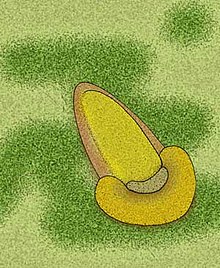| Temnoxa molluscula Temporal range: Ediacaran, around 558–555 Ma PreꞒ Ꞓ O S D C P T J K Pg N ↓ | |
|---|---|

| |
| Schematic reconstructions of Temnoxa molluscura | |
| Scientific classification | |
| Kingdom: | Animalia |
| Phylum: | incertae sedis: Arthropoda? Mollusca? |
| Genus: | †Temnoxa Ivantsov et al. 2004 |
| Type species | |
| T. molluscula Ivanstov et al. 2004 | |
| Species | |
| |
Temnoxa molluscula is a small creature approximately 8 mm wide found in the Ediacaran period (558-555 Ma) in Russia. The Temnoxa has a resemblance to a vertically cut penny bun mushroom. Due to the lack of information regarding the fossils of this organism, researchers are unable to place Temnoxa molluscula into any known phylum. The genus was originally discovered by Russian paleontologist Andrey Yu. Ivantsov in 2004.
Due to its body lacking metameric (linear series of body segments) appendages, it's highly hypothesized that this creature was closest related to mollusks. However, there are opposing theories regarding the accuracy of this categorization because its unsegmented body and U-shaped head is far too large to be considered a mollusk. It also lacks a single shield-like mantle, although a mantle-like structure appeared to slip away from a dorsal side of the body in the holotype.
Temnoxa molluscula also appeared to lack a respiratory and sensory processes. This creature may have had a crawling foot. Its bilateral symmetry suggests motility in Temnoxa. Another reason scientists hypothesize mobility for this organism is because in 2017, researchers from around the world observed the way that water flowed around its shell. It was discovered that they were able to face the direction of the water current using their U-shaped heads, and are most likely the oldest known species to have this capability. They may have been able to attach themselves to substrate using their sticky foot. This organism is compact yet flexible, able to enclose a visceral mass. Nevertheless, no direct fossil evidence exists for internal organs (Ivanstov et al. 2012).
Temnoxa shares certain features with other Ediacaran creatures, such as Kimberella and Parvancorina.
See also
References
- Fodonkin, Mikhail (2007). "Ediacaran Fauna".
- Ivantsov, A. Yu; Malakhovskaya, Ya. E.; Serezhnikova, E. A. (4 June 2002). "Some Problematic Fossils from the Vendian of the Southeastern White Sea Region". Paleontological Journal. 38: 1–9 – via MAIK.
- Freeman, Gary (15 October 2009). "The rise of bilaterans". Historical Biology. 21 (1–2): 114. doi:10.1080/08912960903295843. S2CID 83841216.
- Ivanstov, A. Yu (2012). "Paleontological Data on the Possibility of Precambrian Existence of Mollusks". Mollusks: Morphology, Behavior and Ecology. 5: 27 – via Nova Science Publishers.
- Salisbury, David (19 May 2017). "Life in the Precambrian may have been much livelier than previously thought". ScienceDaily.
- Budd, Graham (2017). "The origin of the animals and a 'Savannah' hypothesis for early bilaterian evolution: Early evolution of the animals". Respositorio Institucional Universidad de Extremadura – via DEHESA., who is citing Grazhdankin (2014) .
- Fendonkin, Mikail (28 August 1997). "The Late Precambrian fossil Kimberella is a mollusc-like bilaterian organism". Nature. 388 (6645): 868–871. Bibcode:1997Natur.388..868F. doi:10.1038/42242. S2CID 4395089.
| Taxon identifiers | |
|---|---|
| Temnoxa | |